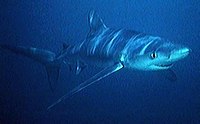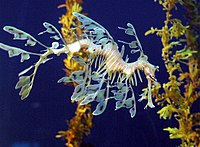
Back Аԥсыӡ Abkhazian Eungkôt ACE Vis Afrikaans Fische ALS Балык ALT ዓሣ Amharic Foting AMI Pisces AN Fisc ANG मछली ANP






Fish (plural: fish or fishes) are a group of animals which live in water and respire (get oxygen) from their gills. As a group, they are much older than other vertebrates. The first fish developed about 500 million years ago.[4]
Fish used to be a class of vertebrates. Now the term covers five classes of animals that live in the water:
There are more fish than four-limbed animals: there are over 33,000 described species of fish.[5] Fish are usually covered with scales. They have two sets of paired fins and several unpaired fins. Most fish are cold-blooded (poikilotherm).
There are many different kinds of fish. The thing to remember is that they all have adaptations, which are the features which let them live in the way they do. Yes, they do all live in water. But living in a fast-flowing river is different from living in a slow-moving river. In the sea, it matters the depth they live at. They live in fresh water in lakes and rivers (freshwater fish), and in salt water (marine fish) in the oceans. Some fish are less than one centimeter long. The largest fish is the whale shark, which can be almost 15 meters long and weigh 15 tons. Almost all fish live in the water. A group of fish called the lungfish have developed lungs because they live in rivers and pools which dry up in certain parts of the year. They burrow into mud and aestivate until the water returns.
The English word "fish" is not just one phylum. Some fish are more closely related to land animals than they are to other fish. For example, lobe-finned fish were the first animals with bones to come live on land, and all land animals are their descendants. Lobe-finned fish are more closely related to humans than to ray-finned fish.[6]
- ↑ Leafy and Weedy Sea Dragon National Geographic Profile. Retrieved 20 July 2009.
- ↑ Connolly R (2006). Phycodurus eques. 2006 IUCN Red List of Threatened Species. IUCN 2006. Retrieved on 20 July 2009.
- ↑ Long J.A. 1995. The rise of fishes: 500 million years of evolution. Johns Hopkins, Baltimore.
- ↑ Long J.A. 1995. The rise of fishes: 500 million years of evolution. Johns Hopkins, Baltimore.
- ↑ FishBase
- ↑ Chris Woolston (April 17, 2013). "'Coelacanth' Genome Unlocked". Scientific American. Retrieved August 4, 2022.